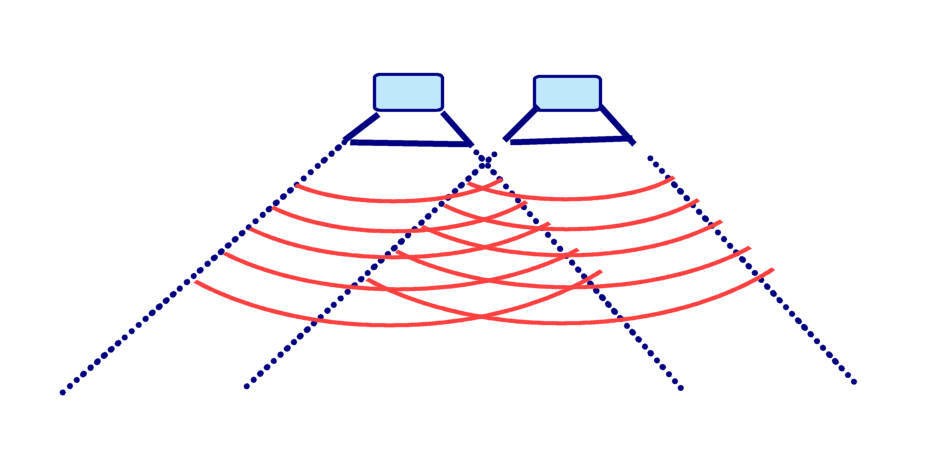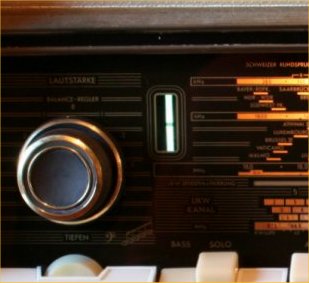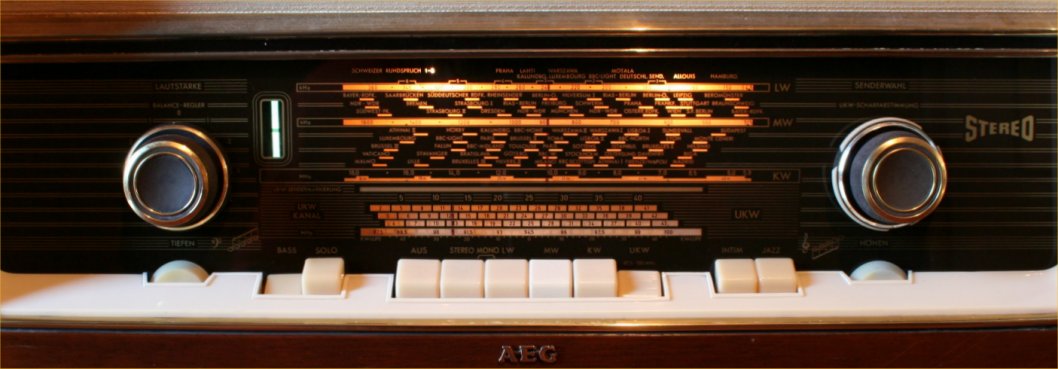 tambour 61 - en
tambour 61 - en
AEG Tambour 61 Stereo – en
- by giovanni
AEG TAMBOUR 61 STEREO
AEG TAMBOUR 61 STEREO
The original cabinet was built by AEG but the frame, electronic parts and various components derived from Telefunken even if it is the same company.
For example, the AEG Tambour 61 is the same Telefunken Concertino 2194 rebranded. The device is particular because it has different stages at medium frequency respecting all other vintage devices.
In this case the device has an MF amplifier stage and Automatic Frequency Control (AFC) which fits automatically once tuned into the station while it remains excluded during the search.
In all other devices, pressing the AFC button you get perfect tuning stability, but during the search it is only possible to receive the strongest station; conversely without pressing the AFC button it is possible to receive all the stations but the tuning is unstable.
AEG and Telefunken have developed a brilliant system to resolve this problem as explained as follows:
In FM modality, the radio reception is absolutely perfect and free from rustles.
The section of low frequency is magnificent because there are two finales in A- class equipped with a couple of ELC86.
The ELC86 are excellent vacuum tubes. The A-class does the rest.
The power, by virtue of the body of the loudspeakers at high efficiency is remarkable and the sound is very sweet and energic.
Regarding the position of the loudspeakers, the sound remains about the same, from whatever angle you listen to the device.
This makes it more enjoyable and affords the opportunity to listen to music and the programmes whilst multi – tasking.
Lastly, the furniture is shiny and in an excellent state. It is well proportioned, with innovative design and evokes the waves of a Lyra.
The vacuum tube is almost double or triple for the total amount of 17 single vacuum tubes.
- AFC automatic excludable


-
STEREO
Separate amplifiers for left and right sides. -
BLUETOOTH
Bluetooth receiver embed -
MULTI PLATFORM CONNECTION
Each radio is equipped with a cable for connection to any digital device.
TUBESOUND IMPROVEMENT
- Bluetooth receiver embed - The unit is equipped with a BLUETOOTH receiver powered directly by the receiver power supply. This makes it possible to control the amplifier from any external digital device as an IPAD, a Smartphone, or a sophisticated multimedia station. So you can hear your preferred web station or your lossesless file without cables on the room. Wireless Receiver can be equipped upon requests.
– Multi Platform Connection – A customized adaptation cable to connect any digital device as Iphone, Smartphone, Laptop, CD Player etc. will be provided with this radio. This special cable suits the different impedances between the modern equipment and the receiver. Furthermore the two stereo channels flow into one without increasing the load to the input unit.


HISTORY
In 1883 AEG “Allegemaine Electricitats Gesellschaft “ ( General Company of Electricity ) was born thanks to Emil Rathenau, an engineer from Berlin. He bought Edison’s lightbulb license and started to commercialize it in Germany through his company “Deutsche Edison Gesellschaft” (OEG)( German Edison Company .
In 1887 AEG presented the first electrical appliances during a World Exhibition; an iron kettle and curling tongs.
AEG became the most important electrical producer in Germany.
In 1903 AEG together with Siemans A.G founded Telefunken. The idea was to transform Telefunken into the first technology company with video - radio – electrical and military skills in Germany.
In 1907 AEG hired the architect and designer Peter Behrens as industrial engineer.
In 1911 Kaiser Guglielmo sent Telefunken’s engineers in West Sayville (New York) to build a radio tower 180 metres high. A similar tower was erected in Nauen ( Germany), creating the unique wireless communication network between North America and Europe. During construction of the tower in New York the German employees were forbidden access to the American employees in the work area.
In 1912 AEG produced the “famous Dandy” hoover and from that moment, dominated the German market with constant innovation to equip the home and professional environment.
Today, AEG belongs to the Electrolux Group.
MAIN FEATURES
Year of production: : 1961
Superheterodyne IF: 472/10700
8 AM Circuits 11 FM Circuits
Wavebands: LW, MW, SW, FM
Loudspeakers:
2 elliptical fullrange
2 Tweeters
Dimensions (LHD): 640 x 375 x 270 mm / 25.2 x 14.8 x 10.6 inch
Net weight: 14.3 kg / 31 lb 8 oz
9 Tubes: ECC85 ECH81 2xEF89 EM84 EABC80 ECC83 2xECL86
Rotating ferrite aerial for AM bands

LOUDSPEAKERS
Two front speakers emission behaviour
Each of the two front speakers has a fairly wide angle of emission.
Standing in front of the radio, centrally located, the output areas of the two loudspeakers intersect.
In monophonic listening, the acoustic feeling is to hear from a single central speaker.
But being two, the emission surface is very high, producing the same sound impact as a large woofer.
At the same time, the two front speakers, having smaller and lighter membranes and reels than a single large woofer, so they are much faster.
The low frequencies are therefore more ready and tail-free, and the range in the high frequencies is very extensive.
An expensive but highly performing choice.
TONE CONTROL
The tone control system is very efficient. Above the large tone control knobs there is a band that lights up gradually indicating the emphasis on the band on which it acts.
KLANGREGISTER

Klangregister, sound registers, are buttons that introduce the prearranged equalization curves. They are divided into two groups, on the right and on the left of the button range selection.
Bass: emphasizes the low loudness
Solo: introduces the medium loudness
Intimi : reduces the high notes
Jazz: enhances the high notes

AERIALS
Inside the cabinet there is a dipole for FM reception and a ferrite rotating aerial for AM reception.
Ferrite aerial can be rotated from the outside to achieve a perfect tuning of the device in the AM.
In this picture see the rotation mechanism and the position indicator of the aerial.
The reception sensitivity with internal aerials is very good. This unit was in fact produced in a period when there were not many radio stations and those available fairly apart from each others.
Using an external aerial sensitivity is further increased.
SEPARATE CONTROL TUNING BETWEEN AM AND FM
The tuning system is another gem.
The unit is equipped with mechanisms for keeping separate the AM and FM bands.
The movement is transferred to both mechanisms with a system of pulleys and separated gears.


AFC AUTOMATICALLY EXCLUDABLE
This an exclusive feature of this device, the Automatic Frequency Control (AFC) that excludes itself automatically.
The mechanism works like this:
To tune into any FM station it is necessary to rotate the biggest knob, the one with the silver edge.
To rotate it, just press on the white small pipe the AFC, via the internal contacts of the knob, then it is possible to tune into all the stations with both the strongest and weakest signal.
As soon as you release the knob, through the same contacts, the AFC automatically inserts itself and the station is engaged at the maximum power.
Other devices do not appear to use this system. Too much expensive I suppose!
TUNING INDICATOR
The magic eye has of course been replaced.

CONTROL PANEL

On the left there is the volume command (with the incorporated loudness) and axially to this, the balance command.
The Magic Eye indicates the perfect tuning each station.
The AM band for the long, medium short waves and FM band.
Below from the left, there are in order the bass knob, the Bass and Solo buttons, powering off, Stereo Record Player, Mono Record Player, buttons for tuning in long, medium and short waves, FM buttons, Intim and Jazz. At the end the check high notes knob.
Under each button is shown the frequency band.
Finally, there is the tuning knob, coaxial AM and FM, which makes the movement pleasant because it is supported by a two fly- wheel.

REAR SIDE
Output for external speakers.
Socket for recorder (tonbandgerat).
Turntable input (Tonabnehmer)
AM and FM aerial inputs and ground socket.
RESTORATION STEPS
THE USUAL AMAZING LAST IMAGE





























